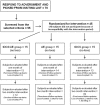Transcranial Direct Current Stimulation Combined with Aerobic Exercise to Optimize Analgesic Responses in Fibromyalgia: A Randomized Placebo-Controlled Clinical Trial
- PMID: 27014012
- PMCID: PMC4785149
- DOI: 10.3389/fnhum.2016.00068
Transcranial Direct Current Stimulation Combined with Aerobic Exercise to Optimize Analgesic Responses in Fibromyalgia: A Randomized Placebo-Controlled Clinical Trial
Abstract
Fibromyalgia is a chronic pain syndrome that is associated with maladaptive plasticity in neural central circuits. One of the neural circuits that are involved in pain in fibromyalgia is the primary motor cortex. We tested a combination intervention that aimed to modulate the motor system: transcranial direct current stimulation (tDCS) of the primary motor cortex (M1) and aerobic exercise (AE). In this phase II, sham-controlled randomized clinical trial, 45 subjects were assigned to 1 of 3 groups: tDCS + AE, AE only, and tDCS only. The following outcomes were assessed: intensity of pain, level of anxiety, quality of life, mood, pressure pain threshold, and cortical plasticity, as indexed by transcranial magnetic stimulation. There was a significant effect for the group-time interaction for intensity of pain, demonstrating that tDCS/AE was superior to AE [F (13, 364) = 2.25, p = 0.007] and tDCS [F (13, 364) = 2.33, p = 0.0056] alone. Post-hoc adjusted analysis showed a difference between tDCS/AE and tDCS group after the first week of stimulation and after 1 month intervention period (p = 0.02 and p = 0.03, respectively). Further, after treatment there was a significant difference between groups in anxiety and mood levels. The combination treatment effected the greatest response. The three groups had no differences regarding responses in motor cortex plasticity, as assessed by TMS. The combination of tDCS with aerobic exercise is superior compared with each individual intervention (cohen's d effect sizes > 0.55). The combination intervention had a significant effect on pain, anxiety and mood. Based on the similar effects on cortical plasticity outcomes, the combination intervention might have affected other neural circuits, such as those that control the affective-emotional aspects of pain.
Trial registration: (www.ClinicalTrials.gov), identifier NTC02358902.
Keywords: aerobic exercise; combined therapy; fibromyalgia; motor cortex; transcranial direct current stimulation (tDCS).
Figures







References
-
- Cagnie B., Coppieters I., Denecker S., Six J., Danneels L., Meeus M. (2014). Central sensitization in fibromyalgia? A systematic review on structural and functional brain MRI, in Seminars in Arthritis and Rheumatism, eds Hochberg M., Altman R., Gottlieb N., Bykerk V., Lane N., Anselm, Karen M., Joachim O., Sieper, Steen V., Richard Hebel J. (Belgium: Elsevier; ), 68–75. - PubMed
Publication types
LinkOut - more resources
Full Text Sources
Other Literature Sources
Medical

